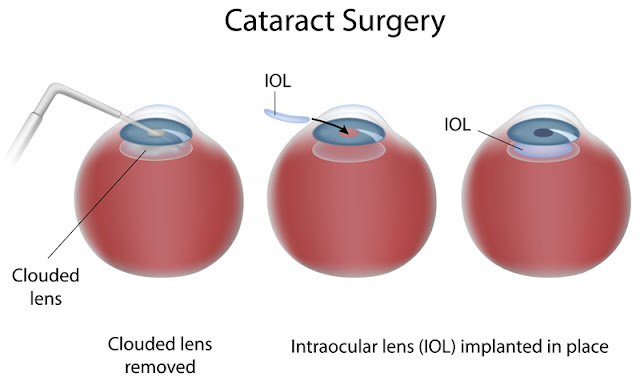
Cataract surgery is an operation in which the lens is removed from the eye and replaced with an intraocular lens in most cases. Cataract surgery, also called lens replacement surgery, is the removal of the natural lens (also called the “lens”) of the cloudy eye called cataract and replace it with an intraocular lens.
 |
| Types of Cataract Surgery |
IOLs will not repair cataracts, but about 4-6 months after surgery, so-called "secondary cataracts" may occur. This is not a real cataract, but a capsule problem, that is, the cellophane shell that contains the natural lens and the replacement lens.
Types of Cataract Surgery
The most common type of cataract surgery is called phacoemulsification, or phacoemulsification for short. Phacoemulsification (a type of ultrasound) is the most common method for removing cataracts. Artificial intraocular lenses (IOLs) are used to replace the natural lens of the eye, which is removed during cataract surgery.
Cataract Surgery Types in India
Phacoemulsification, or phaco
 |
| Phacoemulsification - Cataract Surgery |
Extracapsular Surgery
Your doctor makes a long incision at the edge of the cornea and removes the cloudy part of the lens in one piece. The remaining lens is removed by suction.
Before cataract surgery, antibiotic eye drops may be prescribed to prevent infection. Cataract surgery is often performed as an outpatient procedure with local anesthesia (a numbing gel is placed in the eye) and mild intravenous sedation. You should not see the instruments coming towards your eye and you should not feel pain in your eye during the surgery. The incision made to remove the cataract is so small that it usually does not require stitches. Phacoemulsification (a type of ultrasound) is the most common method used to remove cataracts.
Cataract Surgery Surgical Options
Intraocular Lens (IOL)
 |
| Intraocular Lens (IOL) |
 |
| Intraocular Lenses - Cataract Surgery |
- Standard lens implants are monofocal, meaning they are designed to correct vision over a single focal length. If a patient chooses to have the correct IOL implanted for far vision in both eyes, he or she will most likely need glasses for reading. Some patients choose an IOL that corrects their vision for a distance in one eye and an IOL that corrects their vision in the other eye.
- Premium IOLs include presbyopia-correcting IOLs and toric IOLs. The decision to use these lenses should be made on an individual basis.
- Presbyopia-correcting intraocular lenses are designed to correct for distance and near vision. The intended goal of these lenses is to reduce the need for glasses.
- Toric intraocular lenses are used for patients with astigmatism. Astigmatism refers to an irregularity in the curvature of the cornea. Toric IOLs are designed to correct farsightedness and astigmatism.
Femtosecond Laser
Femtosecond laser is another option available for your doctor to use during cataract surgery. It is an FDA-approved, computer-guided laser that is programmed by a surgeon. This device can assist the surgeon in performing some of the steps involved in removing the cataract. It can also be used in procedures to correct astigmatism.



Eye glasses are the part of our life who having difficulty in vision. But one should always choose light weight and comfortable frame also choose good size of frame which cover your eye from each side. You can take advice from expert or from an ophthalmologist in Ludhiana.
ReplyDelete